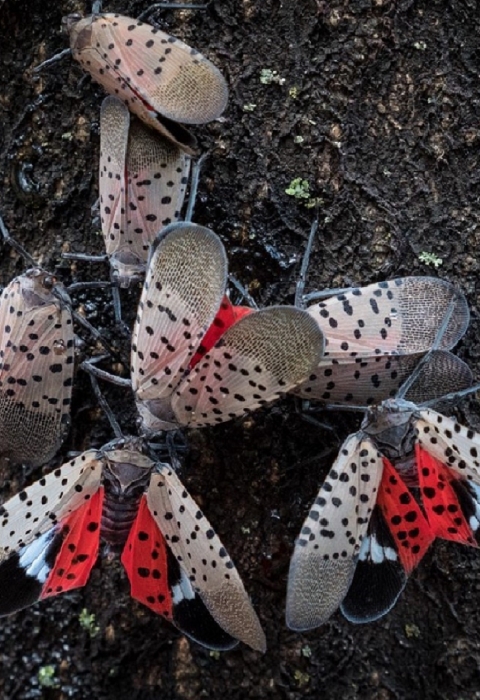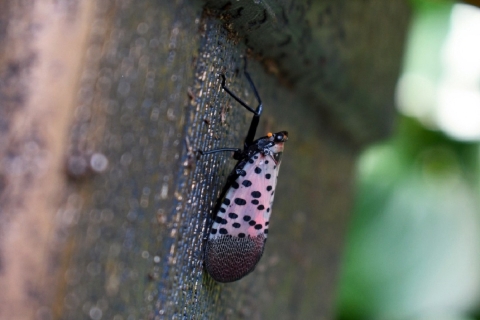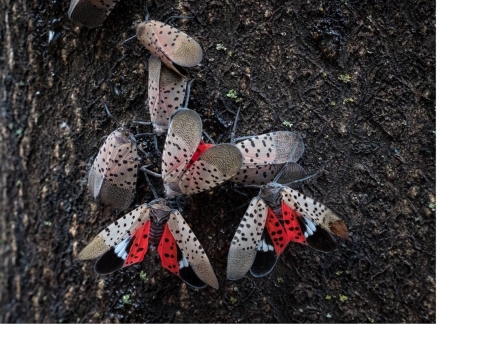For what it’s worth, Zach Ladin seems like the type of guy for whom a folk festival would spark a scientific epiphany.
The supervisory wildlife biologist for the Northeast Region’s Migratory Bird Program has long hair and almost a surfer-dude drawl. A copy of “Dune” sat on the bookshelf behind him, as we chatted about Artificial Intelligence for 10 minutes before getting to our intended topic — a study he led along with colleagues at the U. S. Forest Service, Pennsylvania Department of Conservation and Natural Resources, and the University of Delaware after witnessing festival-goers disperse to their cars from a packed festival shuttle. It’s a pretty big festival, he explained; people come from all over.
As he sat on the shuttle watching a spotted lanternfly crawl across a woman’s backpack, he realized these insects are probably getting into our cars and getting a free ride to spread across the East Coast.
That’s basically the thesis of the study that published in “Scientific Reports” this January. Using a simple-but-powerful computer model that tracks the actions of individuals, Ladin and his team found that human dispersal — by way of cars, trucks, trains, etc. — is likely driving the spread of the spotted lanternfly throughout the eastern U.S.
And they’re spreading quickly.
The spotted lanternfly is an invasive insect native to parts of China and Vietnam. Since it was first detected in Pennsylvania in 2014 (coincidentally, where the music festival was), spotted lanternfly has been found in 13 other states: Connecticut, Delaware, Indiana, Maryland, Massachusetts, Michigan, New Jersey, New York, North Carolina, Ohio, Rhode Island, Virginia and West Virginia.
The species’ spread in the U.S. is particularly concerning because it threatens grapes, fruit trees, and hardwood trees — all economically valuable plants.
"So naturally, California is deathly afraid of this particular insect arriving,” Ladin said.
The good news for the state’s vintners and farmers is that the study showed the Rocky Mountains are a sizeable barrier to the lanternfly’s spread. However, the threat of a lanternfly catching a ride coast to coast in baggage remains. Ladin hopes the study raises awareness of these potential stowaways, whether they’re in suitcases or car wheel wells.
Understanding human footprints everywhere
The study provides information so people can make better decisions.
“I think it can help guide individual human behavior by [getting people] saying, ‘OK, we are taking this road trip this summer, and we just stopped at that gas station where there were a ton of lanternflies around. Maybe we should really, really check our car super well,” Ladin said.
Pennsylvania has official protocols to prevent tractor-trailer drivers from carrying the insects on their journeys.
"They even have dogs that will go around and sniff out if there are lanternflies,” he said.
The study suggests that these more systemic, transportation-targeted control measures are more effective than tracking down and killing individual insects or smashing egg masses.
Homeowners can radically slow the insect’s spread if they have a tree-of-heaven in their yard they’re willing to remove. An invasive species invasive species
An invasive species is any plant or animal that has spread or been introduced into a new area where they are, or could, cause harm to the environment, economy, or human, animal, or plant health. Their unwelcome presence can destroy ecosystems and cost millions of dollars.
Learn more about invasive species itself, tree-of-heaven is the lanternfly’s preferred host and harboring one can increase the rate of spread.
The main outcome Ladin hopes for is broader awareness — not just of how humans facilitate the insect’s spread, but of how our actions are constantly affecting and altering the ecosystems we are part of.
He cited the initial phase of the coronavirus pandemic as an example of how humans can unknowingly expedite the spread of an invader — pointing to a broader lack of awareness of how our movements affect lives and systems other than our own. It’s important to recognize how humans’ footprints in one place can impact ecosystems in another.
"This [lanternfly spread] is like the canary in the coal mine of biological invasion. This stuff's happening. It's a signal to us on how we need to modify and course-correct. [It shows us] how we're doing things as a society, how globalization is helping move species around willy-nilly with no real forethought,” Ladin said.
“Why aren't we tapping into that information and letting it guide us?” he said.
Listening to such cues about our impact on the earth can be important guidance in addressing climate change climate change
Climate change includes both global warming driven by human-induced emissions of greenhouse gases and the resulting large-scale shifts in weather patterns. Though there have been previous periods of climatic change, since the mid-20th century humans have had an unprecedented impact on Earth's climate system and caused change on a global scale.
Learn more about climate change as well: “If we've altered the ecosystem so much so that [this is happening,] it's not going to be functioning quite the way it probably should in order to keep us healthy and surviving, to keep our water and our soils and our air and our vegetation communities healthy enough to support us.”
Climate expediting
Global climate change will only accelerate the lanternfly’s geographic spread and population growth.
Ladin’s model incorporated bioclimatic variables that help demonstrate how warming temperatures can influence the species' spread, and it predicted that a warming climate will expand the species’ potential geographic range.
Usually, the species reproduces once a year, but experts have additionally found that without seasonal temperature differences, spotted lanternfly can reproduce multiple times a year — exponentially increasing growth rates.
At the moment, most of the Service’s work to contain the lanternfly’s spread comes in the form of education campaigns — so that people can identify the insect, learn how to kill its egg masses, and remember to check their vehicles before driving.
At the Pennsylvania/New York border, for instance, interns with Broome County Parks — funded by the Service’s New York Field Office — educate visitors and manage for spotted lanternfly and tree of heaven.
Ladin et al. study is now one more essential tool in understanding and broadening that informative work.





